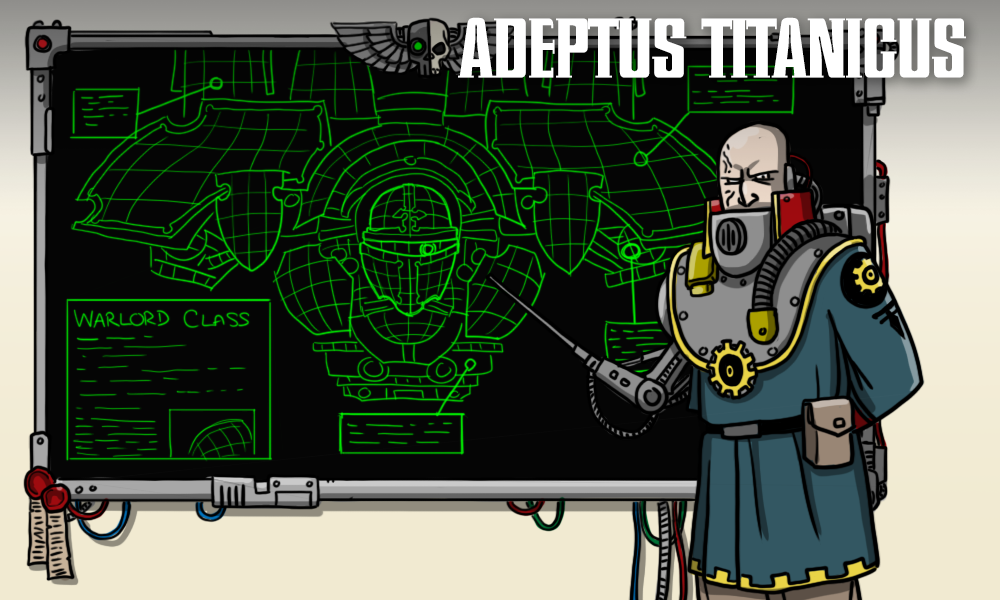This article was originally published on October 9, 2019. However its content is still valid today and if you haven’t given the game a shot yet we would implore you to give this a read, then give playing with tiny titans a shot. You won’t be disappointed.
Welcome to Goonhammer’s series for aspiring Titan Principes. We here at Goonhammer’s own Collegia Titanica know that Adeptus Titanicus can seem intimidating to players unfamiliar with its particular quirks, but this series aims to equip you with everything you’ll need to play out epic clashes on the battlefields of the far future with your very own Titan Battlegroup. In this series, we’ll be walking you through how to build your battlegroup and command it to glory, including everything from which Titans to include and how to equip them, through to how to command them on the field of battle to secure ultimate victory. Today, we figured we’d begin by introducing you to this amazing game and helping you get started. Future articles in this series will cover the various list-building options on offer and finish up with tactical advice that will help you get the most out of your own god-engines.
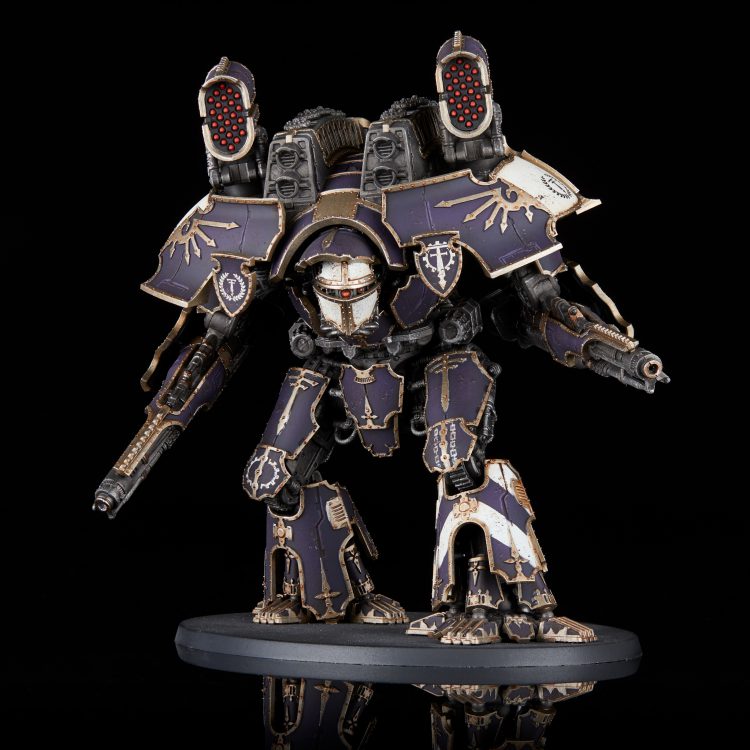
So what is this weird game you want me to play?
Adeptus Titanicus is a skirmish wargame that pits battlegroups of titanic bipedal warmachines, each carrying absurd amounts of firepower, in epic clashes with each other and, more often than you might expect, the surrounding structures and other scenery. It combines crunchy, tactical gameplay with a dash of unpredictability to create an experience that is as close to being reasonably described as “cinematic” as a tabletop wargame can get. You’ll carefully plan out your advance across the board, managing sight-lines and taking care not to expose your vulnerable flank to your opponent’s big guns, all the while working to set up that critical shot that will score you an engine kill. And even if you miss, you’ll probably blow up a nearby building or something.
In addition to moving your models around the battlefield, each Titan comes with a Command Terminal that puts all the information you need to know in order to use it in one handy place, and also keeps track of the damage it’s taken to its head, body, legs, and weapons. As your Titan takes damage, it will slowly become less effective as its weapons disable, its locomotors seize up, and its crew are wounded and killed, until eventually an attack strikes home and it’s finally destroyed. But Titans don’t go down without a fight, and you’ll find that they can soak up an incredible amount of damage before they die. Games of Adeptus Titanicus combine a spectacular flow of play with a pleasantly crunchy ruleset, and you’ll quickly find yourself drawn into the flow of battle and left hanging on every die roll.
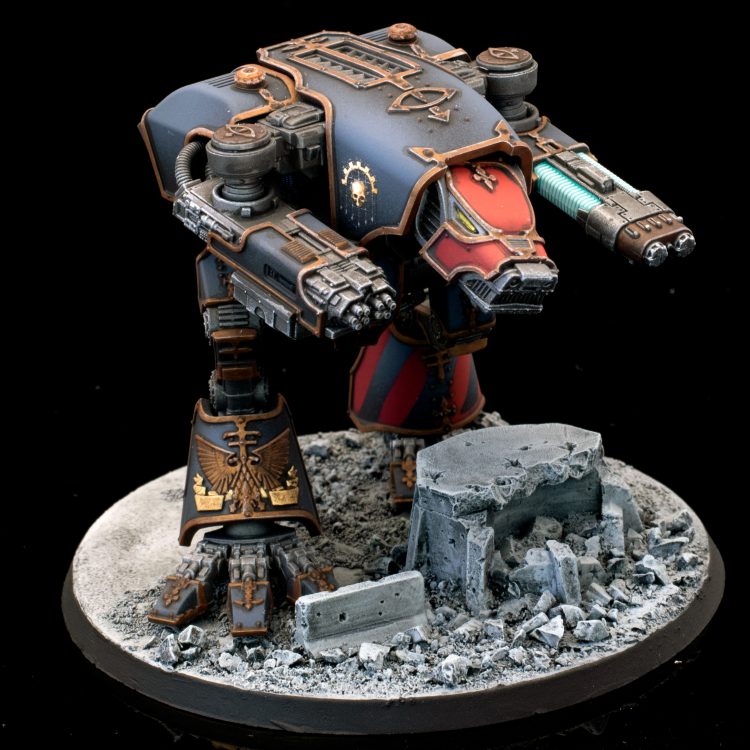
Why should I play Adeptus Titanicus?
For my money, AT is one of the best games Games Workshop have ever released, bringing together many of the best parts of tabletop wargaming to create a truly amazing final product. I could go on at length about how much I love this game, but if I had to boil it down to three points, I’d pick these:
- The Models – Games Workshop have really outdone themselves with the model range for Titanicus. Each Titan is incredibly detailed and a blast to build, and they offer plenty of opportunity to go wild and try out new techniques. The Warlord model alone is packed with detail for you to get in there and really flex your fine detailing skills, and its armor panels are the perfect place for some freehanded heraldry to show off your creativity. Reavers and Warhounds are similarly covered in small bits for you to pick out and highlight, and the tiny plastic Knight kits are honestly kind of adorable. When all is said and done, Titanicus offers some of the best models in GW’s entire catalog.
- The Rules – AT has a tight, streamlined set of rules that let you make meaningful decisions from the start of your first turn right through to the end of the game. Something as simple as managing the various tracks on your Titans’ Command Terminals has a great tactile element, and there’s something deeply satisfying about moving your Void Shield marker back to full after a good repair roll. Titan movement is deliberate, even lumbering, and the weapons they bring to bear are incredibly destructive, so every choice you make counts. Deal enough damage to a Titan, and it might simply grind to a halt and serve as LoS-blocking terrain for the rest of the game, or it might tumble to the ground, crushing any hapless models or structures it falls on. Push your Titan’s reactor too hard and its machine spirit might take offense, momentarily seizing control of the god-engine from its crew when you least expect it. And how many games have you played where you can aim at a giant bipedal weapon of mass destruction, completely miss your shot, and accidentally level a nearby hab block?
- The Price – While the individual models are expensive, the number of models you need to play a game is relatively low, so the total price of a full maniple is much more reasonable than you’re probably thinking. The new 2020 starter set is fantastic value, coming with everything you need to play the game with 1250-point list for $150, and most games you play won’t go much above 1500 points. You can easily expand from this force in any direction once you’ve had a few games to fill out your battlegroup for less than you would spend to build a 2000-point army for most factions in 40k.

Alright, I’m in. What do I need to get started?
Before this year, there were a few different approaches to get into the game, although with the release of the new Starter Set in Feburary 2020, the answer is simple. Get the Starter set
- The 2020 Adeptus Titanicus Starter set
- Even before the release of this new Core Set, our recommended starting point (Warhound box, one of each Reaver box, and the Rules set) would get you most of the way to a solid, competitive roster for less than $300. This Core Set gives you everything in our recommended starter pack plus a pair of Cerastus Knight Lancers for $150. Put another way, you’re paying the same as both Reavers and the Knights would cost individually, which means the Warhounds and the entire Rules pack are effectively free. If you’ve been waiting for a cheaper way to get into the game, you’re not going to do any better than this.The set includes the core rules, weapon cards, enough Titan terminals to get you started, and all the dice, stratagem cards, and tokens you’ll need to play. And that’s before we look at the Titans! Reavers and Warhounds form the core of many lists, and having a pair of each is a good start for almost anyone. Additionally, getting one of each Reaver box gives you access to the full panoply of loadout options, letting you build a solid take-all-comers list right out of the gate.
- Table space. Adeptus Titanicus is typically played on a 4’x4’ table. I usually play set up in the middle of a 6’x4’ table so there’s space on either side to put Titan terminals.
- Terrain. As with any wargame, building an AT table is something of an art, but you want to have a decent number of LoS blockers with some open firelanes that your long-ranged Titans can take advantage of. Good AT boards will have plenty of terrain to play around, but make sure you leave enough room on the main thoroughfares for Titans to maneuver through. If you’ve got the Dropzone Commander Cityscape or Ruinscape boxes, they make great starting points, though anything you’ve got lying around will work.
- An opponent. Grab a friend and get ready to slug it out.
If you follow this advice, you’ll have a solid starter force that you can easily expand to around 1500 points, which is roughly what you’ll want to have on hand for most pick-up and matched play games.
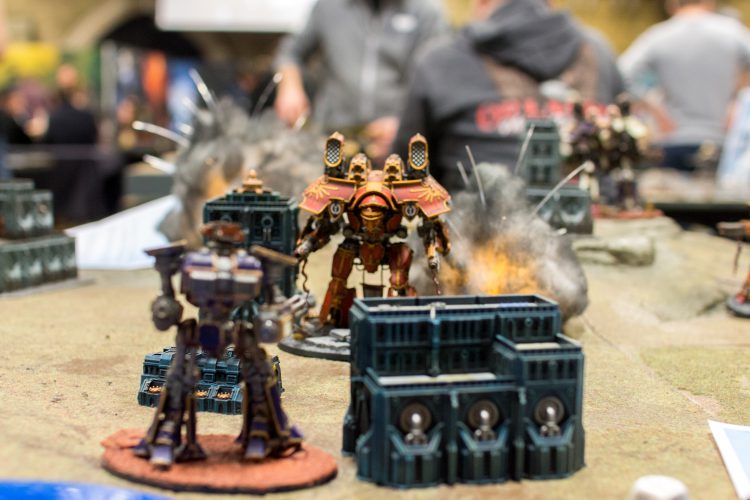
OK, I’m in. How do I play?
Titanicus has five phases, each of which have multiple steps. In later articles, we’ll dive more into each of those phases and give some pointers on how to command your Titan Battlegroup to victory. For now, here are a few key points to pay attention to:
- Prioritize Key Orders. If your plan for the game revolves around a particular order going off this turn, issue that order earlier than other, less important orders. Missing a command check will not only stop the order in question from being issued, but will also prevent you from issuing any other orders that turn. Don’t run the risk of not being able to full stride your melee Reaver across the board because you decided to throw a random split fire on your Warlord for lack of any better ideas.
- Move with purpose. The Movement Phase is the heart of this game, and you should treat it as such. Unlike games like 40k where you can move and shoot in any direction, a canny player can step just out of their opponent’s firing arcs and line up a punishing counterattack. Think carefully about the order in which you activate your Titans – activating later in the turn order means you’ll know where most of the fire arcs are pointed before you move.
- Think before you push. Your Titans’ reactor tracks aren’t endless, and every time you roll the reactor die has a chance to advance that track twice. This isn’t much of a concern on a Warlord, but means that one bad roll could put a Warhound in danger of melting down. Also keep in mind that if you push during the Combat Phase (or use the Maximal Fire trait on a weapon), any advancement on the reactor track won’t be able to be cleared until the next round’s Damage Control phase. Take a second to think before you commit to draining attacks or push Voids to Full in the Combat Phase.
- Have a plan to kill every Titan you meet. Many weapons in Titanicus are powerful, but several of the strongest weapons in the game have severe drawbacks that you need to be able to plan around. The highest-strength weapons in the game usually have either the Blast trait or the Melee trait, both of which can make it difficult to secure a kill. The downside to Melee weapons is fairly obvious – getting within 2″ with the Titan carrying it intact will take several turns and careful play. The Blast trait is a little less obvious – weapons with the Blast trait can’t make called shots, which means that you’ll have difficulty focusing fire on the same location repeatedly. When you’re building your battlegroup, think about how you can build to give yourself the chance to land a killing blow as soon as possible, whether that’s through an aggressive push into close range, concentrated fire from mid-range onto a specific structure track, or just drowning a particular Titan in shots. No matter your strategy, you’re given the tools necessary to enact it, but you’ll need to build in order to take advantage of those tools.
- Squad up your Warhounds. A Warhound not in a squad is a shameful Warhound – not only can it not merge its voids with its squadmates to keep its shields up longer, it also loses access to the powerful Coordinated Strikes rule, which combined with their maneuverability makes a pair of Warhounds a serious threat to any model in your opponent’s battlegroup. Essentially, you’re exchanging an extra activation here for some added durability in the early game and a little more punch against armor, which will help set up devastating or critical hits earlier and more reliably. As you become more familiar with the game, you’ll learn that there are situations where fielding Warhounds outside of a squad makes sense, but fielding them in pairs will make them a bit more forgiving to play while you’re still learning the rules. We’ll go into more detail on these situations in later articles.
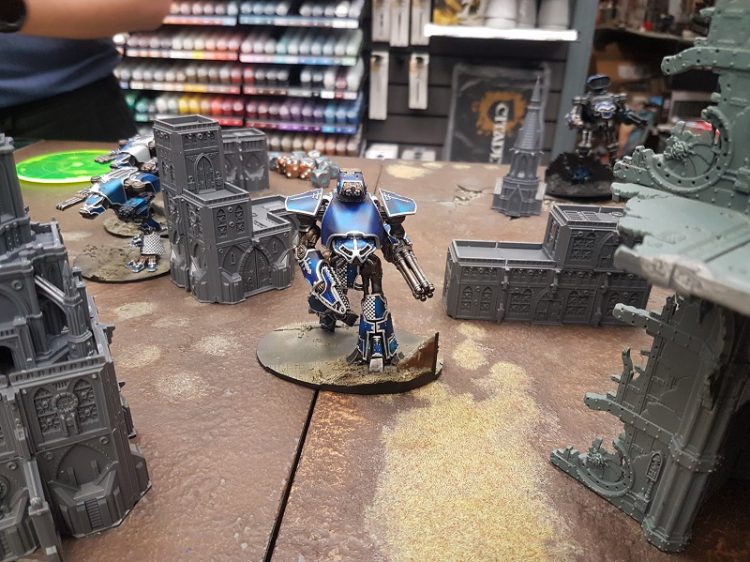
This is by no means an exhaustive list of tips, but you will notice a common thread here: have a plan for how you intend to approach the game, and make sure the decisions you’re making play into that plan. For your first few games, we recommend a plan that looks something like this:
- Use high-shot count weapons to collapse void shields on your first target. Weapons like the Apocalypse Missile Launcher and Vulcan Megabolter are excellent at generating piles of void saves for your opponent to fail. Focus on bringing down shields one Titan at a time for now – you’re rewarded for doing so due to the lower save value as you go down the track.
- Fire your high-strength weapons at unshielded targets until you pick up a few points of structure damage on a given track. Your first shots into armor won’t benefit from a bonus to the armor roll, so you might as well roll the location die and let them land where they may. This is the part of the plan where weapons like the Belicosa Volcano Cannon, the Melta Cannon, or the Plasma Blastgun on maximal fire come into their own, blowing holes in your opponents’ armor so your next set of shots will be more effective.
- Stack armor roll bonuses with called shots to finish off your victim. Once you’ve racked up 3-4 points of structure damage on the same location track, your further shots will start to get bonuses to their armor rolls. This means that each individual shot is more likely to cause significant damage, so you can afford to take the risk on called shots and start going for the kill. At this stage, start retasking your Titans with weapons like the AML or Megabolter to pounding down shields on your next target, and start it all over again.
This is a very bare-bones outline, but will help you think about the best way to equip and position your Titans so you can bring the right weapons to bear on the right targets. For some more detail on which weapons fit in what category, Warhammer Community has an excellent post about these three categories and some examples of weapons that belong in each.

Where do I go from here?
Now that you’ve played your first game and gotten a feel for the system, it’s time to expand your battlegroup to add more options and let you play larger games. Expect to be able to field 1500 points for most pickup games – the rules in the core manual allow for up to 2500, but even 2000 points is pushing it on game length – that’s a serious time sink that will take several hours to play through. The rules also allow for an underdog bonus – if you have fewer points than your opponent, you get some help including additional stratagem points and other benefits. These bonuses can be helpful, but you should probably try to stay within about 200 points of your opponent – any more of a difference between forces tends to make for an uneven game that neither player will find satisfying.
As far as what to look for next, there are many ways you could expand your collection. In the coming weeks we’ll go over the various options available to you to help you decide how to build out your collection, including the various Titan Legios, Maniples, and other features you can use to build the force of your dreams. These rules can be found variously in the Core Manual that came with your starter set or any of the supplements that have been released since such as Titandeath, Doom of Molech, Shadow & Iron, and the new Loyalist Legios book. We’ll go into more depth on these in the future as well.
